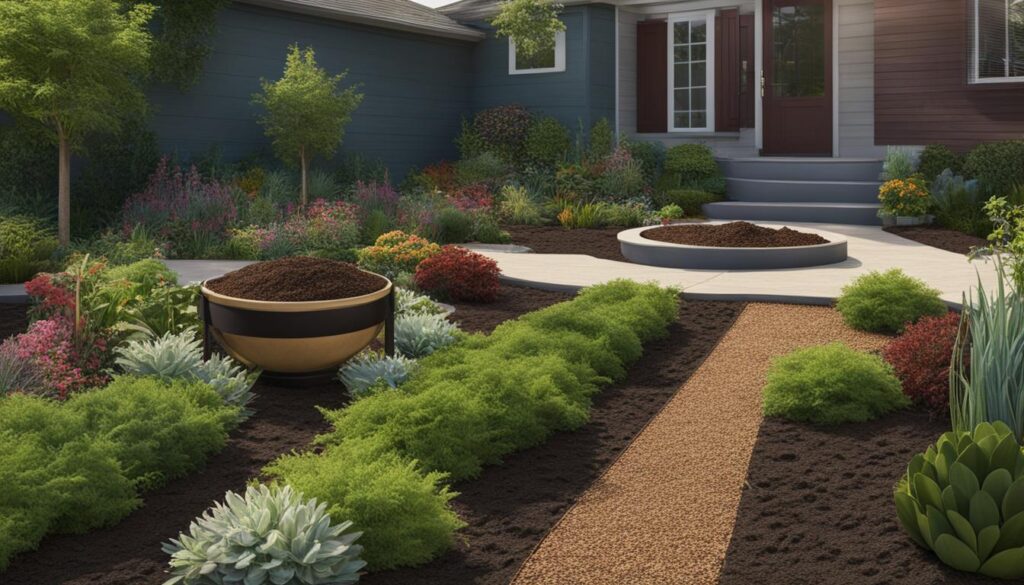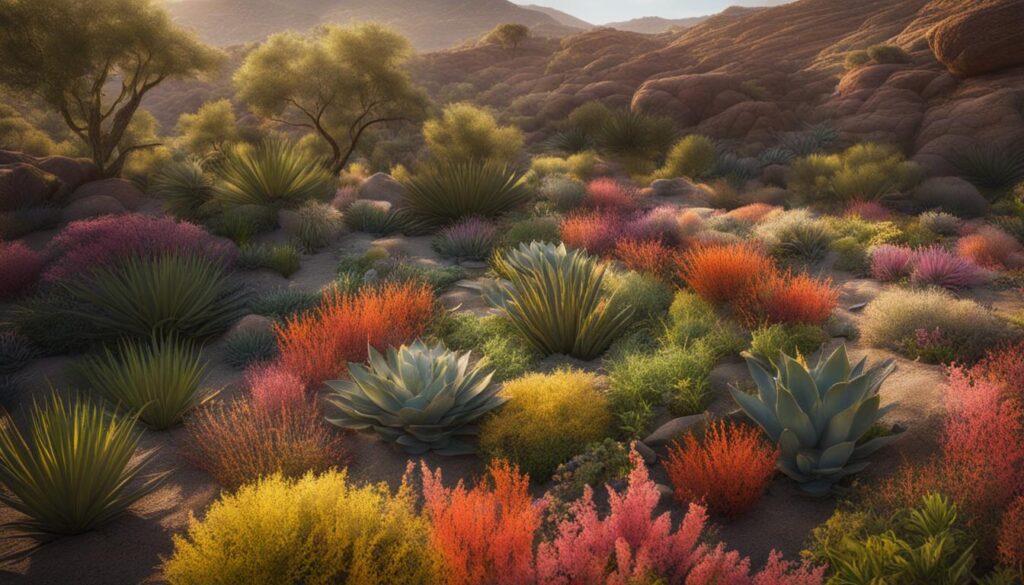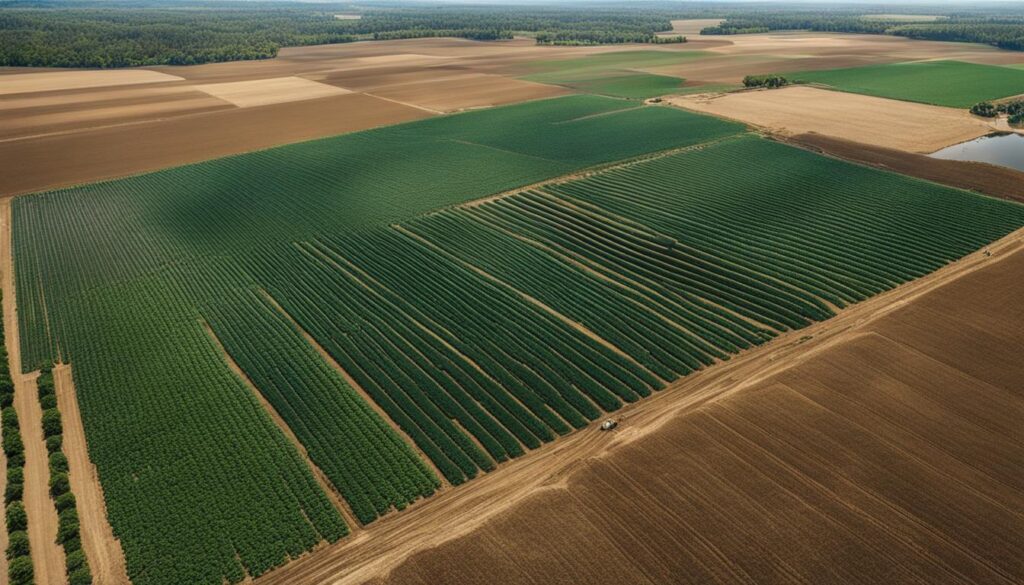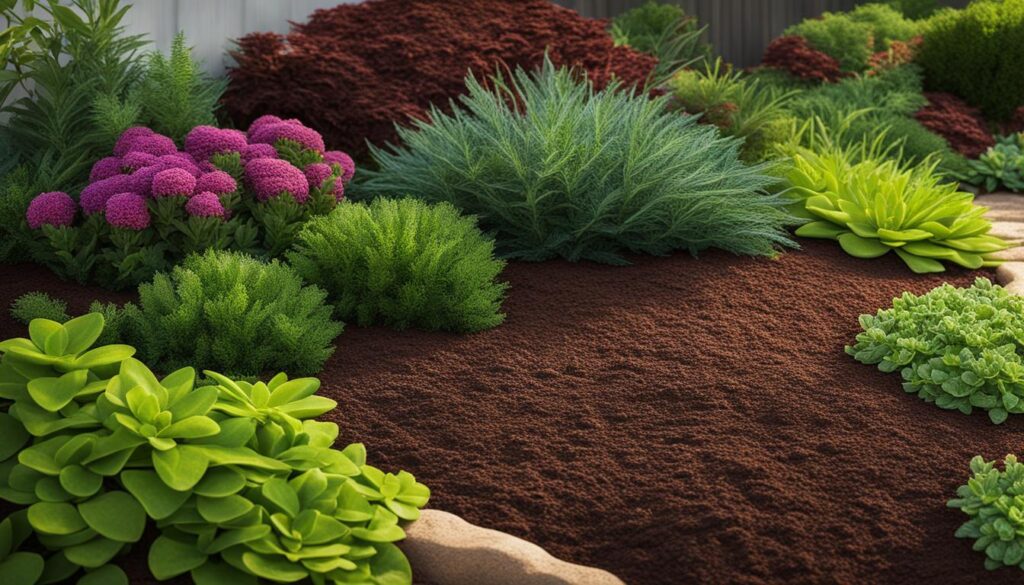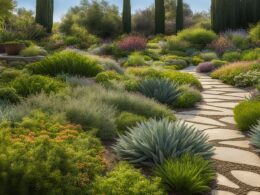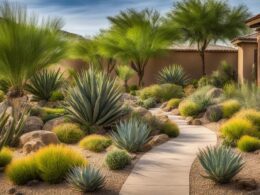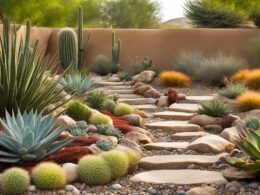Designing a landscape that conserves water and energy is possible with the right soil cover options. By incorporating water-saving techniques into your landscaping, you can improve water retention, reduce wastage, and promote healthy soil. This article explores various soil cover options for water conservation based on factual data from credible sources.
Key Takeaways:
- Choose the right soil cover option to improve water retention in your landscape.
- Consider using mulch, ground cover, or living plants to protect soil from evaporation and runoff.
- Soil cover helps prevent soil erosion, suppress weed growth, and improve soil fertility.
- Using organic and natural materials for mulch and ground cover enhances water conservation efforts.
- Proper soil cover selection contributes to a greener, more sustainable future.
Understanding Watering Techniques for Water Conservation
When it comes to water conservation in your garden, understanding proper watering techniques is crucial. By adopting efficient watering practices, you can maximize water usage and minimize wastage. Here are some key watering techniques to help you conserve water while keeping your plants healthy and thriving.
1. Determine your plants’ watering needs
Not all plants have the same watering requirements. It’s essential to understand the specific needs of each type of plant in your garden. Some plants prefer consistently moist soil, while others thrive in drier conditions. By knowing the watering needs of your plants, you can tailor your watering schedule accordingly, delivering the right amount of water to each plant.
2. Consider evapotranspiration (Et) rate
Evapotranspiration (Et) rate is the measure of water loss through evaporation from the soil and transpiration from the plants. It varies depending on factors such as temperature, humidity, wind speed, and sunlight. To conserve water, it’s ideal to water your plants in the early morning when the Et rate is lowest. By doing so, you can reduce water loss due to evaporation and ensure that the plants can efficiently absorb the water.
3. Use smart irrigation techniques
Implementing smart irrigation techniques can significantly contribute to water conservation. Drip irrigation systems are particularly efficient, as they deliver water directly to the plant’s root zone, minimizing water waste. Additionally, using mulch around your plants can help retain moisture in the soil, reducing the frequency of watering.
4. Monitor soil moisture levels
Regularly monitoring the moisture levels in your soil is essential to avoid overwatering or underwatering your plants. Use a moisture meter or simply stick your finger into the soil to determine its moisture content. Water your plants only when the soil is dry to a specific depth, as indicated by the plant’s watering requirements.
By following these watering techniques, you can effectively conserve water in your garden while promoting the health and vitality of your plants. Remember, every drop counts when it comes to water conservation!
Implementing Xeriscaping Principles for Water Conservation
Implementing xeriscaping principles is a practical and effective way to conserve water in your landscape. Xeriscaping is a landscaping technique that focuses on minimizing water usage while maintaining an attractive outdoor space. By following the seven basic xeriscaping principles, you can create a drought-tolerant landscape that promotes water conservation regardless of your regional climate.
Planning and Design
The first principle of xeriscaping is planning and design. This involves evaluating your landscape’s needs, considering water availability, and selecting appropriate plants and materials. By designing a well-thought-out landscape that maximizes water efficiency, you can reduce water usage and create a visually appealing environment.
Selecting and Zoning Plants Appropriately
The second principle is selecting and zoning plants appropriately. It is important to choose plants that are native or adapted to your region’s climate and require minimal water. Grouping plants with similar water needs together and zoning them accordingly will ensure efficient water usage and prevent overwatering or underwatering in different areas of your landscape.
Using Mulches
Mulching is another important aspect of xeriscaping. By applying organic mulches such as wood chips or straw around plants, you can reduce evaporation, suppress weed growth, and regulate soil temperature. Mulches also help retain moisture in the soil, reducing the need for frequent watering.
| Xeriscaping Principle | Benefits |
|---|---|
| Planning and Design | – Efficient use of water – Reduction in water waste – Visual appeal |
| Selecting and Zoning Plants Appropriately | – Water conservation – Reduced maintenance – Healthy plant growth |
| Using Mulches | – Reduced evaporation – Weed suppression – Soil moisture retention |
By incorporating these xeriscaping principles into your landscape design, you can create a beautiful and water-efficient outdoor space. Xeriscaping not only helps conserve water but also reduces maintenance requirements and promotes the health and longevity of your plants. Start implementing these principles today and contribute to a more sustainable future.
The Benefits of Soil Cover for Water Conservation
Soil cover is a crucial component in water conservation efforts, offering numerous benefits for both the environment and agricultural practices. By incorporating soil cover options in your landscaping or farming practices, you can significantly contribute to water conservation and improve overall soil health.
One of the key benefits of soil cover is its ability to promote optimal soil conditions for plant growth. Whether it’s using living plants or mulch as soil cover, it helps to retain moisture in the soil, reducing water loss through evaporation and runoff. This is particularly important in dry regions or during periods of drought, where water availability is limited.
Furthermore, soil cover plays a vital role in preventing soil erosion. By protecting the soil surface from the impact of raindrops, it minimizes the risk of soil particles being carried away by water runoff. This is especially important in sloped areas where erosion can be a significant concern.
The Benefits of Soil Cover for Water Conservation
In addition to its water conservation benefits, soil cover also suppresses weed growth, which can compete with plants for water and nutrients. It acts as a natural barrier, preventing weed seeds from germinating and reducing the need for herbicides or manual weed removal.
Soil cover, whether in the form of living plants or mulch, also helps to improve soil fertility and structure. As organic matter breaks down over time, it enriches the soil with essential nutrients, promoting healthy plant growth. Additionally, soil cover enhances soil structure by preventing soil surface sealing, allowing for better water infiltration and root development.
In summary, soil cover offers a range of benefits for water conservation efforts. By retaining moisture, preventing erosion, suppressing weeds, and improving soil fertility and structure, it plays a crucial role in maintaining sustainable landscapes and supporting efficient agricultural practices.
| Benefits of Soil Cover | Description |
|---|---|
| Promotes optimal soil conditions | Retains moisture in the soil, reducing water loss through evaporation and runoff. |
| Prevents soil erosion | Protects the soil surface from the impact of raindrops, minimizing the risk of soil particles being carried away by water runoff. |
| Suppresses weed growth | Acts as a natural barrier, preventing weed seeds from germinating and reducing the need for herbicides or manual weed removal. |
| Improves soil fertility | Enriches the soil with essential nutrients as organic matter breaks down, promoting healthy plant growth. |
| Enhances soil structure | Prevents soil surface sealing, allowing for better water infiltration and root development. |
Effective Water Management in Drought-Tolerant Landscapes
When it comes to creating and maintaining drought-tolerant landscapes, effective water management is crucial. By implementing efficient watering techniques and utilizing creative solutions for water collection and reuse, you can sustainably manage water resources in your landscape, while still maintaining its beauty and vitality.
To start, consider installing efficient irrigation systems such as drip irrigation. This method delivers water directly to plant root zones, minimizing wastage and ensuring that water reaches where it’s needed most. By using mulch and ground cover materials, you can further retain moisture in the soil, reducing the frequency of watering and promoting water conservation.

Key Strategies for Water Management in Drought-Tolerant Landscapes:
- Install efficient irrigation systems like drip irrigation
- Utilize mulch and ground cover materials to retain moisture in the soil
- Consider creative solutions for water collection and reuse, such as rain barrels or greywater systems
- Incorporate water-saving devices like low-flow shower heads and drip irrigation systems
Effective water management in drought-tolerant landscapes not only helps conserve water but also promotes sustainability and resilience. By implementing these strategies, you can create a thriving landscape that not only survives in dry conditions but also contributes to a greener, more sustainable future.
| Efficient Water Management Strategies | Benefits |
|---|---|
| Drip Irrigation | – Delivers water directly to plant root zones – Minimizes water wastage – Ensures efficient water distribution |
| Mulch and Ground Cover | – Retains moisture in the soil – Reduces evaporation – Regulates soil temperature – Suppresses weed growth |
| Water Collection and Reuse | – Conserves water resources – Reduces water bills – Promotes sustainability |
Efficient water management is key to maintaining the health and beauty of your drought-tolerant landscape. By implementing these strategies, you can make a positive impact on the environment while enjoying a vibrant and sustainable outdoor space.
Selecting the Right Plants for Drought-Tolerant Landscapes
When creating a drought-tolerant landscape, choosing the right plants is essential for long-term success. By selecting plants that are well-suited to dry conditions, you can ensure that your garden retains its beauty and thrives even in the face of water scarcity. Here are some key factors to consider when selecting plants for your drought-tolerant landscape:
1. Native Plants
Native plants are adapted to the local climate and are naturally tolerant of drought conditions. They have evolved to survive with minimal water and require little to no additional irrigation once established. Native plants also provide important habitat and food sources for local wildlife, contributing to the overall health of your ecosystem.
2. Water Requirements
When choosing plants for your landscape, consider their water requirements. Look for plant species that have low water needs and can thrive in arid environments. Drought-tolerant plants typically have adaptations such as deep root systems, succulent leaves, or a waxy coating that helps reduce water loss through evaporation.
3. Soil Conditions
Take into account the type of soil in your landscape when selecting plants. Some plants are more tolerant of sandy or well-drained soils, while others prefer clay or loam. Understanding your soil composition will help you choose plants that can flourish in those conditions and make the most efficient use of water available.
Remember to group plants with similar water and sunlight needs together, as this will make watering and maintenance more efficient. By selecting the right plants, you can create a beautiful and sustainable drought-tolerant landscape that will thrive with minimal water resources.
Efficient Irrigation Systems for Water Conservation
When it comes to water conservation in your landscape, implementing efficient irrigation systems is key. By utilizing smart watering techniques, you can minimize water waste and promote sustainability. Efficient irrigation systems deliver water directly to plant root zones, minimizing evaporation and runoff. Let’s explore some of the most effective irrigation systems for water conservation:
Drip Irrigation
Drip irrigation is a highly efficient method that delivers water directly to the base of plants, ensuring maximum water absorption. This system uses tubes or pipes with small drip emitters that slowly release water near plant roots. Drip irrigation reduces water loss through evaporation and targets water where it is needed the most. By providing a slow and precise water supply, it minimizes water waste and promotes healthy plant growth.
Sprinkler Systems
Sprinkler systems are commonly used for watering large areas but can be adjusted for water conservation. Install sprinklers that have adjustable spray patterns and ensure that they are not watering hardscaped areas or sidewalks. This helps prevent water wastage and ensures that water is distributed evenly across the landscape. Pairing sprinkler systems with rain sensors or moisture meters can further optimize watering by adjusting irrigation schedules based on weather conditions.
Automatic Irrigation Controllers
Installing an automatic irrigation controller can help you efficiently manage water usage. These controllers use weather-based data to adjust irrigation schedules, taking into account factors such as rainfall, temperature, and evaporation rates. By synchronizing watering with actual plant needs and environmental conditions, automatic irrigation controllers eliminate the guesswork and reduce water waste. Coupled with efficient irrigation systems like drip irrigation or sprinklers, these controllers can significantly contribute to water conservation in your landscape.
By implementing efficient irrigation systems, you can conserve water and create a sustainable landscape. Drip irrigation, sprinkler systems, and automatic irrigation controllers are powerful tools that can minimize water waste and promote the health of your plants. Remember to regularly monitor and maintain your irrigation systems to ensure their optimal performance. By adopting these water-saving strategies, you can make a positive impact on your surroundings while enjoying a thriving, beautiful landscape.
Utilizing Mulch and Ground Cover for Water Conservation
When it comes to water conservation in your landscape, utilizing mulch and ground cover can play a crucial role. Mulching not only enhances the aesthetic appeal of your garden but also helps retain moisture in the soil, reducing evaporation and the need for frequent watering. Ground cover, on the other hand, acts as a living mulch, providing additional benefits like suppressing weed growth and regulating soil temperature.
Choosing the right type of mulch is essential for optimal water conservation. Organic materials such as bark, straw, or compost make excellent mulching options as they improve soil structure and help retain moisture. Apply a layer of mulch around your plants, ensuring it is thick enough to suppress weeds but not too thick to suffocate the plants’ roots. Remember to leave a small gap around the base of the plant to prevent moisture accumulation.
Ground cover plants, such as creeping thyme or clover, can be a great addition to your landscape. They form a dense cover that helps retain moisture, prevents soil erosion, and reduces the need for excessive watering. Choose ground cover plants that are well-suited to your region’s climate and soil conditions. Before planting, prepare the soil by removing any existing weeds or grass and adding organic matter to promote healthy growth.
Table: A Comparison of Different Mulch Types
| Mulch Type | Pros | Cons |
|---|---|---|
| Organic Mulch (Bark) | Retains moisture, improves soil structure, suppresses weeds | May attract pests, needs replenishing over time |
| Inorganic Mulch (Gravel) | Durable, doesn’t decompose, retains heat | Doesn’t improve soil fertility, may reflect heat onto plants |
| Living Mulch (Creeping Thyme) | Retains moisture, prevents soil erosion, adds visual interest | May require regular maintenance, can compete with other plants |
As seen in the table above, each mulch type offers unique advantages and disadvantages. Consider your specific gardening needs and preferences when selecting the right mulch for your landscape.
By utilizing mulch and ground cover in your landscape, you can conserve water, promote healthy plant growth, and reduce your overall maintenance requirements. Incorporate these water-saving techniques into your gardening routine for a sustainable and visually appealing outdoor space.
Creative Solutions for Water Collection and Reuse in Landscapes
When it comes to conserving water in your landscape, creative solutions for water collection and reuse can make a significant impact. Implementing these solutions not only helps reduce water usage but also promotes sustainability and environmental responsibility. By incorporating innovative practices, you can contribute to water conservation efforts while enjoying a lush and thriving landscape.
Water Collection
Water collection is a practical way to make the most of natural resources. Rainwater, for example, can be collected from rooftops and stored in rain barrels or cisterns for later use in watering plants. This helps reduce dependency on municipal water supplies and lowers water bills. With the help of efficient gutter systems and appropriate storage containers, rainwater collection can be easily integrated into any landscape.
Water Reuse
Reusing water, also known as greywater recycling, is another effective solution for reducing water waste. Greywater is wastewater from sources like sinks, showers, and laundry machines that can be treated and reused for irrigation purposes. By redirecting greywater to your garden or landscape, you can minimize the need for fresh water while nourishing your plants. However, it’s essential to use eco-friendly cleaning products to ensure the safety and health of your plants.
| Benefits of Water Collection and Reuse |
|---|
| 1. Reduces reliance on municipal water sources |
| 2. Lowers water bills |
| 3. Promotes sustainability and environmental responsibility |
| 4. Minimizes water waste and conserves natural resources |
| 5. Nourishes plants with recycled water |
By incorporating creative solutions for water collection and reuse into your landscape, you can actively contribute to water conservation efforts. Whether through rainwater harvesting or greywater recycling, these practices help reduce water waste, lower your ecological footprint, and promote a greener, more sustainable future.
Enhancing Beauty in Drought-Tolerant Landscapes
Creating a drought-tolerant landscape doesn’t mean sacrificing aesthetics. With the right choices and design considerations, you can enhance the beauty of your outdoor space while conserving water. By incorporating native plants, hardscaping elements, and strategic plant groupings, you can create a visually appealing landscape that thrives in drought conditions.
Native plants are key to creating a beautiful drought-tolerant landscape. These plants are naturally adapted to the local climate and require minimal water once established. Choose a variety of native plants that bloom at different times of the year to ensure year-round color and interest. Incorporate plants with varying textures and heights to add depth and visual appeal to your landscape.
In addition to native plants, hardscaping elements such as rocks, pathways, and decorative structures can add visual interest to your landscape. Incorporating these elements creates focal points and can complement the natural beauty of your plants. Balance the softness of foliage with the ruggedness of hardscaping to create a harmonious and visually appealing landscape.
Creating Visually Cohesive Plant Groupings
When designing your drought-tolerant landscape, consider grouping plants with similar water and sunlight needs together. This approach not only conserves water but also creates visually cohesive plantings. Grouping plants with similar characteristics allows you to design specific areas with different themes or color schemes, adding visual interest to your landscape.
For example, you can create a Mediterranean-inspired garden by grouping plants like lavender, rosemary, and sage together. Alternatively, you could design a vibrant desert garden by clustering colorful succulents and cacti. By carefully planning and grouping plants based on their water and sunlight requirements, you can create visually stunning and water-efficient plantings.
Remember to consider the overall aesthetic of your landscape when selecting plants and designing plant groupings. Aim for a balance between soft and structured elements, utilizing a variety of textures, colors, and shapes. This will create a visually appealing and harmonious landscape that showcases the beauty of your drought-tolerant plants.
How Does Mulching Help with Water Conservation in Soil Cover Options?
Mulching benefits in gardening include water conservation by reducing evaporation, preventing soil erosion, and improving soil structure. By covering the soil with mulch, water retention is increased, reducing the need for frequent watering. This helps plants to access the moisture they need, ultimately conserving water resources in gardening.
Conclusion
In conclusion, designing a drought-tolerant landscape is a practical and sustainable approach to water conservation while maintaining the beauty of your outdoor space. By implementing soil cover options, such as living plants or mulch, you can improve water retention and prevent soil erosion, reducing water loss through evaporation and runoff.
Efficient irrigation systems, like drip irrigation, along with the strategic selection of drought-tolerant plants, ensure optimal water usage. Enhancing water management techniques, such as collecting and reusing rainwater and wastewater, further contribute to the sustainability of your landscape.
With these practical tips, you can create a thriving drought-tolerant landscape that not only conserves water but also adds visual appeal to your surroundings. By making conscious choices and adopting water-wise practices, you play a crucial role in preserving our precious water resources and contributing to a greener, more sustainable future.






